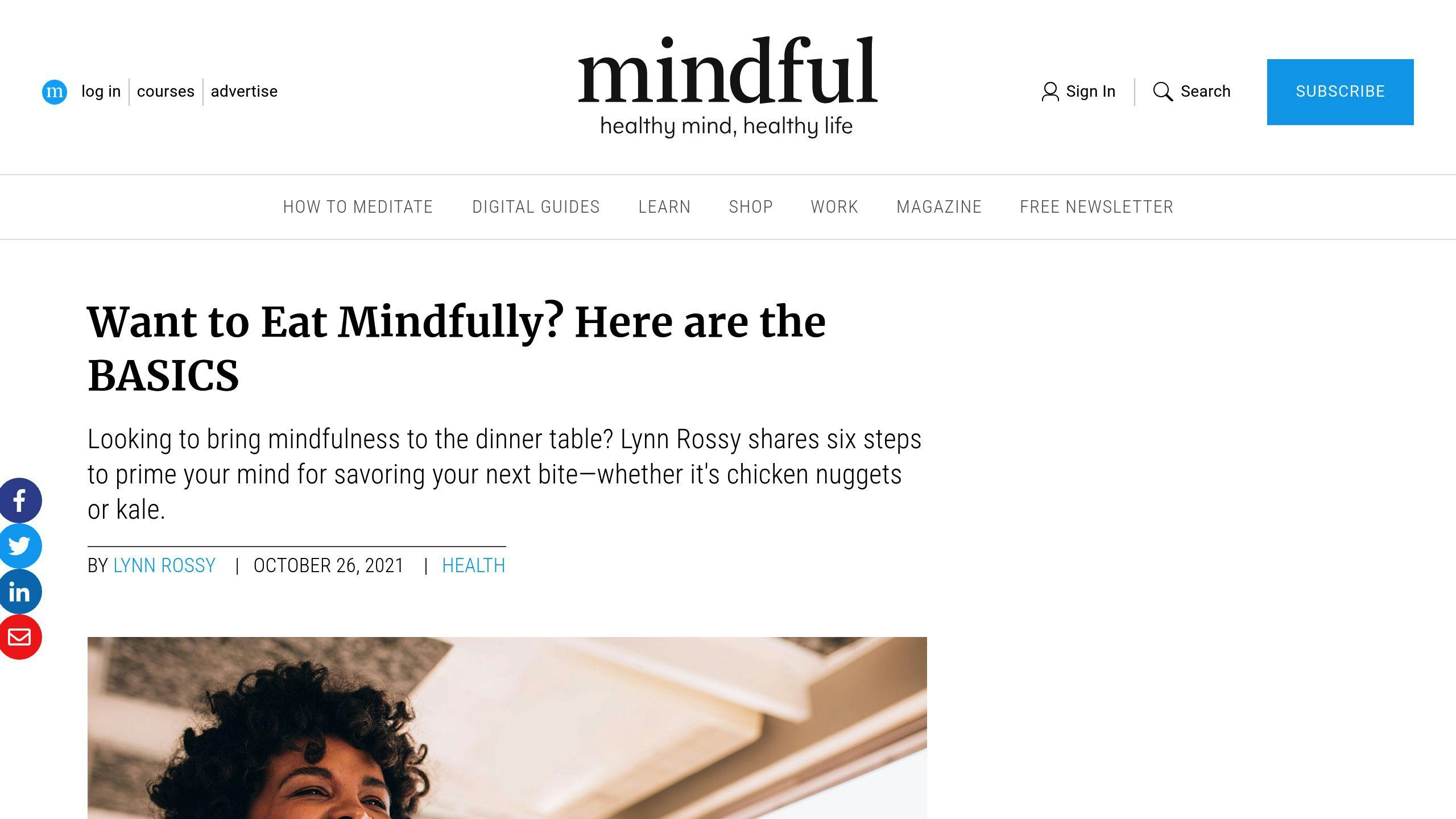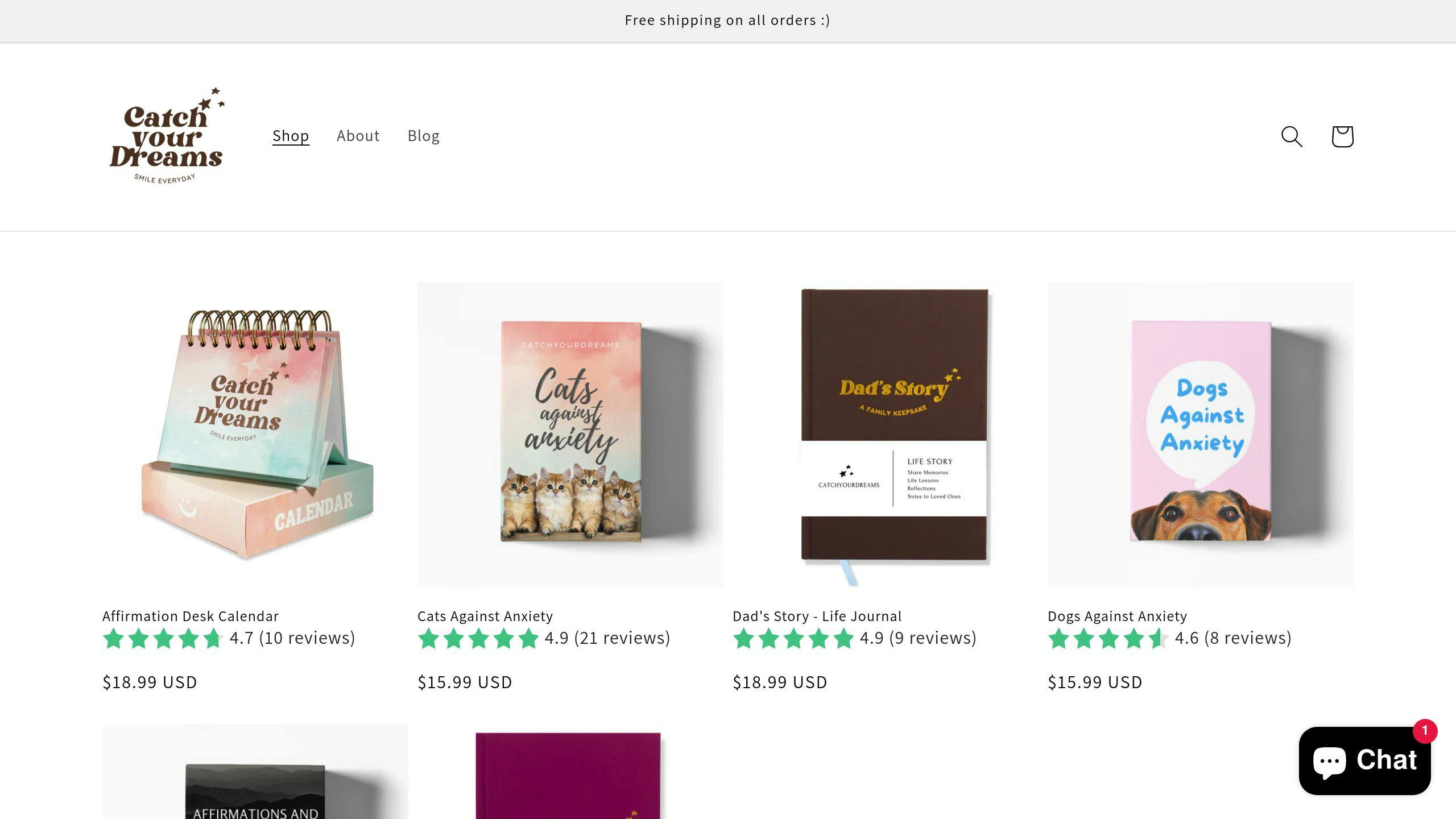
Mindful Eating 101: Beginner's Guide
Share
Mindful eating is about paying attention to your food and how you eat it. Here's what you need to know:
- Focus on the present moment while eating
- Notice your food's colors, smells, and textures
- Listen to your body's hunger cues
- Eat slowly without distractions
Benefits of mindful eating:
- Better portion control
- Improved digestion
- Less stress around food
- Potential weight management
How to start:
- Create a quiet eating space
- Set intentions before meals
- Use all your senses while eating
- Try the BASICS method (Breathe, Assess, Slow down, Investigate hunger, Chew well, Savor)
Mindful eating isn't a diet - it's about building a healthier relationship with food. Start small, be patient, and enjoy your journey to more mindful meals.
| Meal | Mindful Practice | Benefit |
|---|---|---|
| Breakfast | Take 5 deep breaths | Centers your mind |
| Lunch | Use a smaller plate | Controls portions |
| Dinner | No screens | Increases food focus |
Remember: Mindful eating is a skill. It takes practice, but it can change how you think about and enjoy food.
Related video from YouTube
Basics of mindful eating
Mindful eating isn't a diet. It's about paying attention to your food and how you eat it. This approach can help you enjoy meals more and improve your relationship with food.
Main ideas of mindful eating
Mindful eating focuses on:
- Being present during meals
- Using all your senses while eating
- Noticing hunger and fullness cues
- Eating without judgment
To practice mindful eating:
- Slow down and focus on each bite
- Notice the smell, taste, and texture of your food
- Check in with your body before, during, and after eating
- Remove distractions like TV or phones during meals
Mindful eating vs. intuitive eating
Both approaches aim to improve your relationship with food, but they're different:
| Mindful Eating | Intuitive Eating |
|---|---|
| Focuses on the eating experience | Broader approach to overall eating habits |
| Emphasizes awareness during meals | Encourages listening to body cues for all food decisions |
| Can be practiced in specific moments | A lifestyle approach to eating |
| Helps with portion control and enjoyment | Aims to break the diet mentality |
Mindful eating can be a stepping stone to intuitive eating. It helps you tune into your body's signals and enjoy food more fully.
"Mindful eating encourages you to consider pleasure, satisfaction, and nourishment as they choose what foods to eat and how much of them to consume." - Rebecca Bitzer, Author at Rebecca Bitzer & Associates
By practicing mindful eating, you can:
- Reduce overeating
- Improve digestion
- Decrease food anxiety
- Make more confident food choices
How mindful eating helps
Mindful eating can boost your physical and mental health. Here's how:
Enjoying food more
When you eat mindfully, you focus on your food's taste, texture, and smell. This helps you:
- Savor each bite
- Appreciate meals more
- Feel satisfied with less
Better digestion
Mindful eating can improve your digestive health by:
- Cutting stress during meals
- Helping your body break down food
- Making you chew more thoroughly
Healthier food relationship
Practicing mindful eating can:
- Cut guilt around food choices
- Help you make smarter food decisions
- Build a positive attitude towards eating
Possible weight control
While not the main goal, mindful eating might help manage weight:
| Benefit | How it helps |
|---|---|
| Less overeating | You notice fullness cues |
| Better portion control | You pay attention to serving sizes |
| Less emotional eating | You learn to spot true hunger |
Less stress when eating
Mindful eating can lower stress by:
- Slowing you down during meals
- Keeping you focused on the present
- Easing anxiety about food choices
"Mindful eating helps people rebuild their relationship with food. It makes eating less restrictive and judgmental, and it may ultimately lead to more feelings of satisfaction, less guilt and improved self-trust." - Gabrielle Gambino, Senior Clinical Dietitian at New York-Presbyterian Hospital
How to start mindful eating
Want to eat more mindfully? Here's how to get started:
Create a quiet eating space
Cut out distractions:
- No TV or phones
- Eat at a table, not on the couch
- Use plates, not containers
- Soft music if silence feels weird
Set goals before meals
Ask yourself:
- Why am I eating?
- How hungry am I (1-10)?
- What do I want from this meal?
These questions keep you focused.
Use all senses while eating
Engage your senses:
| Sense | How |
|---|---|
| Sight | Check out colors and plating |
| Smell | Breathe in and ID aromas |
| Touch | Feel food textures in your mouth |
| Taste | Savor each bite, notice flavor changes |
| Sound | Listen for crunches or sizzles |
This slows you down and boosts awareness.
"Mindful eating focuses on the why and the how of eating, versus what's promoted by many diets, which are more what to eat, how much to eat, maybe even when to eat." - Maxine Smith, RD, LD
The BASICS method for mindful eating

The BASICS method is a simple way to eat mindfully. Here's how it works:
B: Breathe and check your stomach
Take 5 deep breaths. Rate your hunger from 1 to 10. This stops you from eating when you're not really hungry.
A: Assess your food
Look at your food. Notice its colors and where it came from. This makes you think about what you're eating.
S: Slow down
Put your fork down between bites. Chew slowly. This gives your brain time to realize you're eating.
I: Investigate hunger
Keep checking how hungry you are while you eat. Stop when you're full, not when your plate is empty.
C: Chew well
Chew your food thoroughly. It helps digestion and lets you taste your food better.
S: Savor
Focus on flavors and textures. It makes eating more enjoyable.
Here's a quick reference table:
| Letter | Action |
|---|---|
| B | 5 deep breaths, rate hunger 1-10 |
| A | Look at food colors and origin |
| S | Put fork down between bites |
| I | Check fullness during meal |
| C | Chew each bite completely |
| S | Focus on flavors and textures |
Dr. Lynn Rossy, who created this method, says:
"Practicing with these instructions can change the way you eat forever. It's people's favorite take-away from my class."
Try using BASICS at your next meal. It might change how you eat for good.
sbb-itb-d0aa3ba
Mindful eating exercises
Want to eat more mindfully? Try these exercises:
The raisin exercise
This simple activity teaches you to eat with all your senses:
- Hold a raisin
- Look at it closely
- Feel its texture
- Smell it
- Put it in your mouth (don't chew yet)
- Chew slowly, noticing flavors
- Swallow and reflect
"The raisin activity is a powerful tool for practicing mindful eating. It helps you appreciate your food and develop a healthier relationship with it." - McKel Hill Kooienga, Nutrition Stripped® founder
Planning mindful meals
To eat more mindfully:
- Pick foods you like
- Give yourself enough time to eat
- Put away your phone and turn off the TV
- Use smaller plates
Track what you eat
Keep a food journal. Here's what to write down:
| What to track | Why it's helpful |
|---|---|
| When and where you eat | Spots eating patterns |
| Foods eaten | Shows diet variety |
| Hunger before and after | Helps you recognize true hunger |
| Emotions while eating | Reveals emotional eating triggers |
"Take a 10-minute break before seconds to check if you're really hungry." - Patricia Bannan, MS, RDN
Dealing with common problems
Mindful eating can be tricky. Here's how to tackle some common challenges:
Eating mindfully when busy
Got a packed schedule? You can still practice mindful eating:
- Chew slowly, even if you're in a rush
- Put your fork down between bites
- Focus on your food for the first few bites
Mindful eating in groups
Eating with others? Stay mindful:
- Sit away from the food to avoid grazing
- Check your hunger levels during conversation breaks
- Share what you're tasting to stay food-focused
Managing emotional eating
Emotions often drive us to eat when we're not hungry. Try this:
- Ask yourself: "Am I really hungry?"
- Keep a food and mood diary
- Try deep breathing or a short walk when emotions hit
"Using food to feel better when you're stressed is a learned coping mechanism." - Am I Hungry? Team
Adding mindfulness to daily meals
Let's look at how to make your meals more mindful:
Mindful breakfast tips
Kick off your day right:
- Take 5 deep breaths before eating
- Smell your food first
- Chew slowly, focusing on taste
- Put your fork down between bites
"Start your day with a mindful breakfast!" - Heather J. Leidy, Breakfast researcher
Mindful lunch habits
Make lunch count:
- Eat away from your desk
- Use a smaller plate
- Take your first bite with closed eyes
- Check your hunger halfway through
Mindful dinner practices
End your day mindfully:
- Set a nice table, even when alone
- No screens during meals
- Try chopsticks to slow down
- Express gratitude for your meal
| Meal | Mindful Practice | Benefit |
|---|---|---|
| Breakfast | 5 deep breaths | Centers your mind |
| Lunch | Smaller plate | Controls portions |
| Dinner | No screens | Increases food focus |
Tools for mindful eating
Let's look at some tools to help you eat mindfully:
Apps and books
Here are some apps to try:
| App Name | What it does | Cost |
|---|---|---|
| Am I Hungry?® | Helps you think before you eat | Free |
| Eat Drink and Be Mindful | Tracks hunger and how food makes you feel | Free |
| Mindful Meal Timer | Reminds you to eat slowly | Free |
| Shutterbite | Logs meals and hunger | Free with paid option |
| Eat Right Now | Teaches about emotional eating | Free with paid option |
And some books to check out:
"Eating Mindfully" by Susan Albers Psy.D. mixes research with real stories.
"Savor: Mindful Eating, Mindful Life" by Thich Nhat Hanh and Lilian Cheung combines mindfulness and nutrition tips.
"Mindful Eating" by Jan Chozen Bays explains how mindful eating affects your weight and health.
Classes and workshops
Want to learn more? Try these:
- Go to a Mindful Eating Retreat
- Find mindfulness workshops near you
- Take an online course on Coursera or Udemy
The Center for Mindful Eating (TCME) offers memberships with:
- Webinars (some free, some discounted)
- Education credits
- Old webinars to watch
- Handouts to help you practice
Catchyourdreams website

Catchyourdreams sells stuff to make you feel more positive and mindful. While it's not all about eating, these products can help you be more aware in general, which can help with mindful eating too.
Conclusion
Mindful eating goes beyond just eating slowly. It's about using your senses, ditching food judgment, focusing on how you eat, and listening to your body's signals.
This practice can help you:
- Cut down on binge and emotional eating
- Boost digestion
- Enjoy meals more
- Manage your weight better
Ready to start? Here's how:
1. Create a quiet eating space
Find a calm spot for meals, away from TVs and phones.
2. Use your senses
Notice your food's smell, taste, and texture. Susan Albers, author of "Eating Mindfully", says:
"When you are eating chips mindfully, you take note of their consistency against your tongue and the pressure of your teeth grinding together."
3. Slow down and chew well
Take your time. It'll help you enjoy food more and digest better.
4. Check in with your body
Ask yourself:
- How hungry am I?
- Am I eating because I'm stressed?
- Do I feel satisfied?
5. Keep a food diary
Track what you eat and how you feel to spot patterns.
Remember, mindful eating isn't about being perfect. It's about building a better relationship with food. Gabrielle Gambino, Senior Clinical Dietitian at New York-Presbyterian Hospital, puts it this way:
"Mindful eating helps people rebuild their relationship with food. It makes eating less restrictive and judgmental, and it may ultimately lead to more feelings of satisfaction, less guilt and improved self-trust."
Start small, be patient, and enjoy your journey to mindful meals.
FAQs
How do I start a mindful eating practice?
Starting mindful eating is simpler than you might think:
- Ditch distractions: No TV or phones during meals.
- Use your senses: Really notice your food's smell, texture, and taste.
- Chew slowly: Take your time with each bite.
- Listen to your body: Check your hunger levels before, during, and after eating.
Ashley Braun, RD, MPH, puts it this way:
"Mindful eating is paying attention to our food, on purpose, moment by moment, without judgment. It's about focusing on your sensual awareness of the food and your experience of eating it."
How effective is mindful eating?
Mindful eating can pack a punch. It's been shown to:
- Cut down on emotional and external eating
- Help with weight management
- Make you more aware of your food choices
- Stop overeating in its tracks
A recent study from January 2023 found that people who practiced mindful eating got better at telling the difference between physical and emotional hunger. This led to better portion control and less overeating.
What does the BASICS of mindful eating stand for?
The BASICS method is a handy tool for mindful eating:
| Letter | Meaning |
|---|---|
| B | Breathe and check your stomach |
| A | Assess your food |
| S | Slow down |
| I | Investigate your hunger |
| C | Chew thoroughly |
| S | Savor your food |
This approach, cooked up by mindful eating experts, helps you eat more intentionally and mindfully.
